Thomas Jefferson Memorial
Introduction
Text-to-speech Audio
Images
View of the Jefferson Memorial from the Tidal Basin at dusk. Photo by Joe Ravi, CC-BY-SA 3.0, Wikimedia Commons.
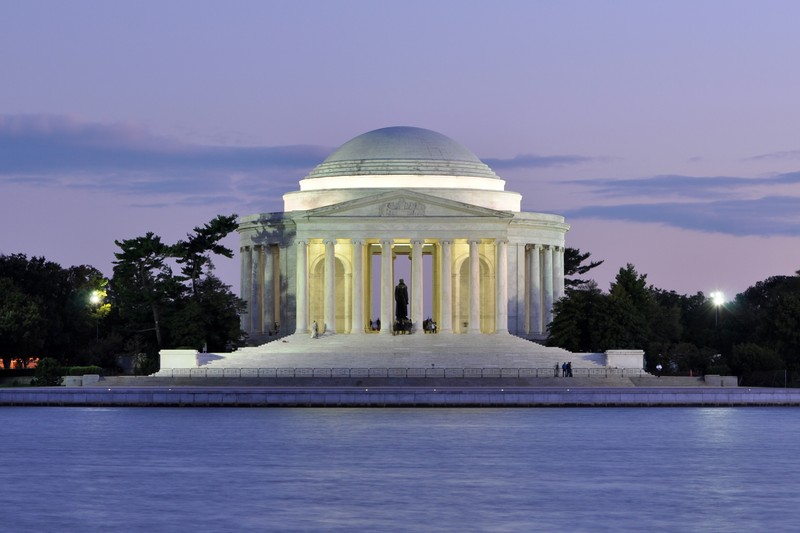
The 19-foot bronze statue of Thomas Jefferson stands by an engraving of the Declaration of Independence. Wikimedia Commons.
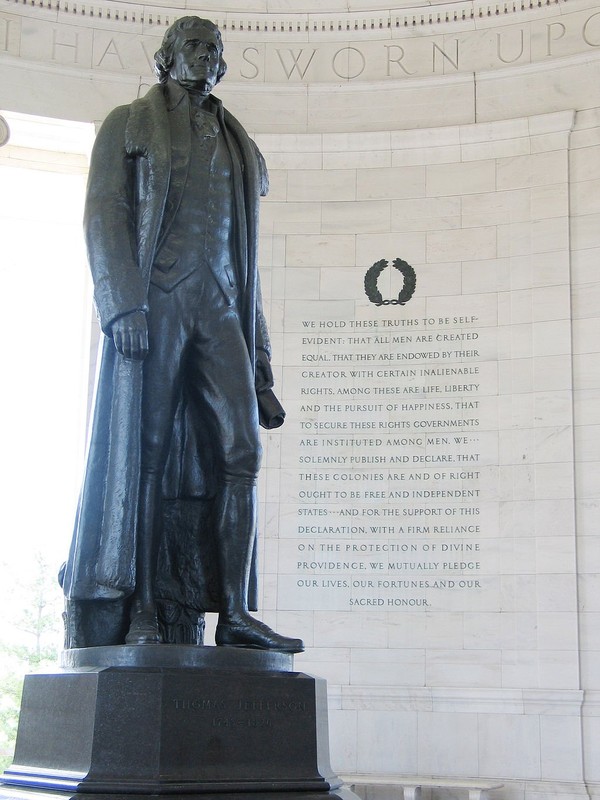
The front portico of the Jefferson Memorial, featuring sculptures of Benjamin Franklin, John Adams, Thomas Jefferson, Roger Sherman, and Robert Livingston on the triangular pediment. Wikimedia Commons.

The Jefferson Memorial location was originally identified by the 1902 McMillan plan as an ideal site for a memorial, aligning directly with the Washington Monument and White House. Photo by Carol M. Highsmith, Library of Congress.
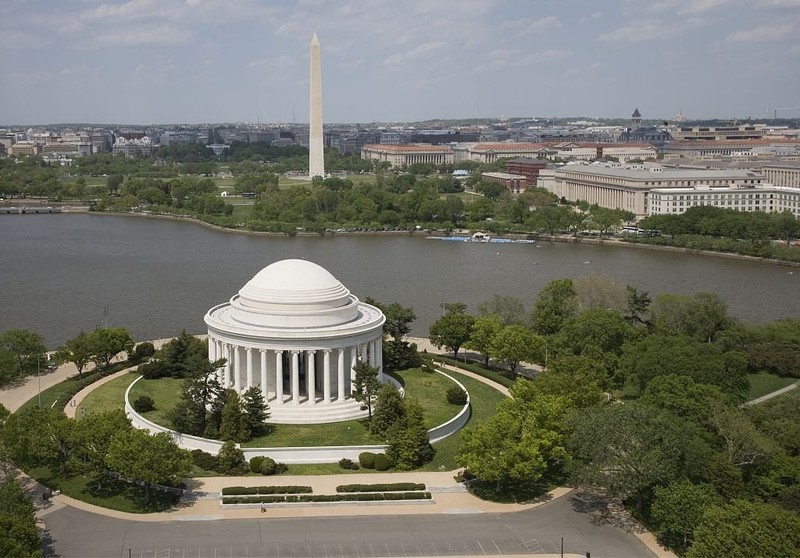
The Jefferson Memorial under construction in 1940. Photo courtesy of the National Park Service.
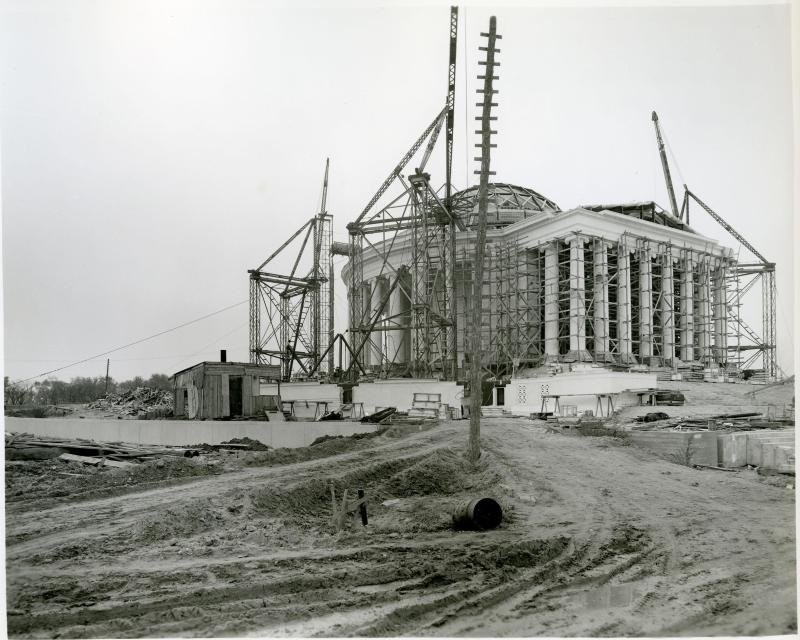
The temporary plaster statue of Jefferson was disassembled after World War II and replaced with the permanent bronze replica. Photo courtesy of the National Park Service.
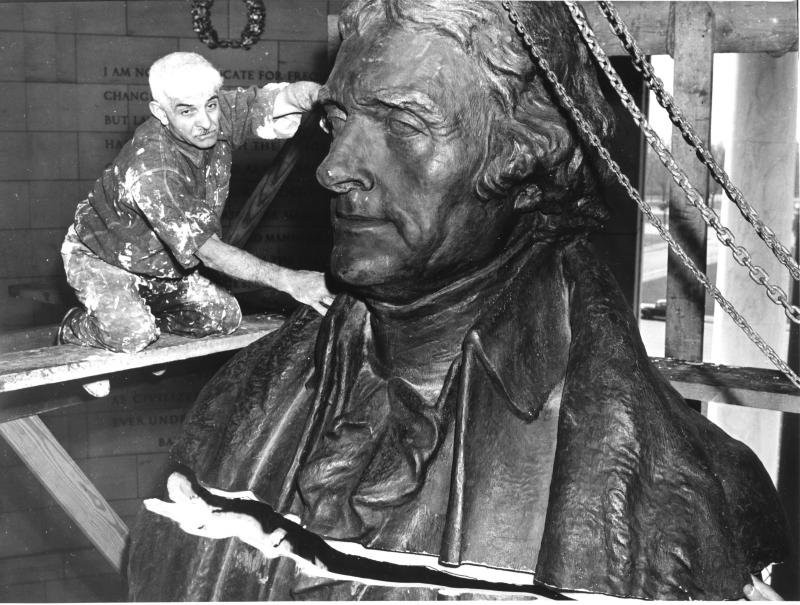
The 5-ton Jefferson statue was rolled up a ramp to the memorial. Photo courtesy of the National Park Service.
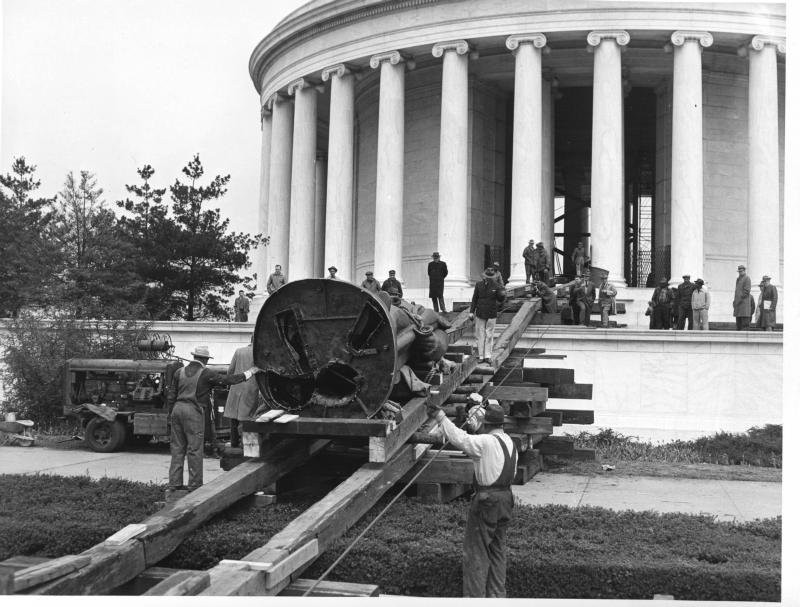
The Jefferson statue narrowly entered through two columns. Photo courtesy of the National Park Service.
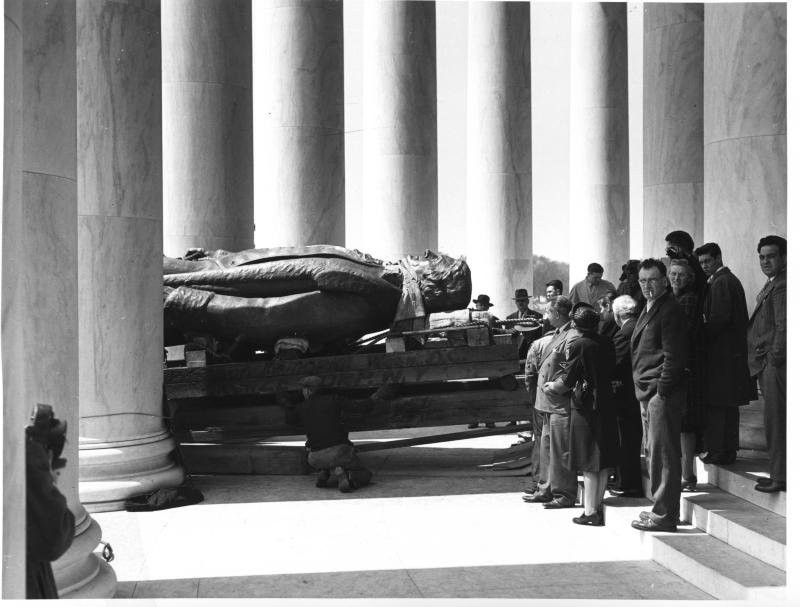
The Jefferson statue was hoisted into place atop a granite pedestal. Photo courtesy of the National Park Service.
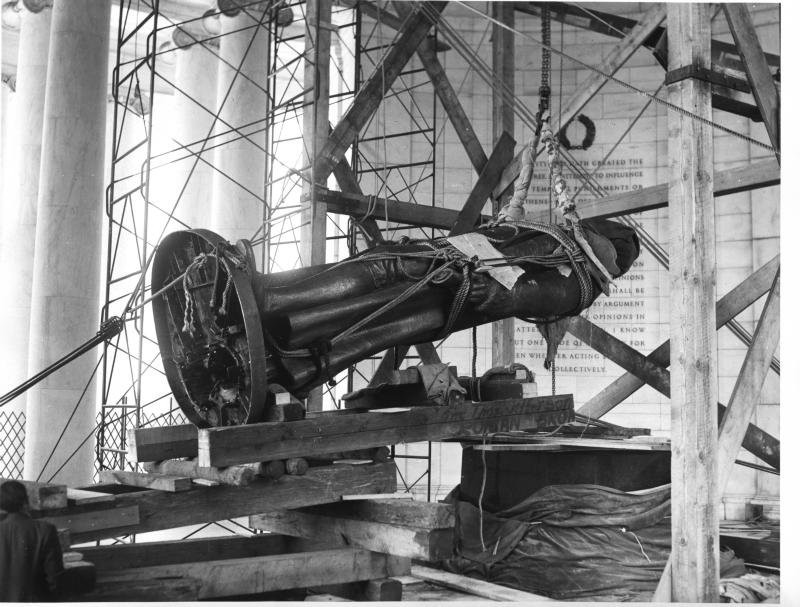
Backstory and Context
Text-to-speech Audio
The Thomas Jefferson Memorial Commission was created by an Act of Congress in 1934, to design a memorial honoring the Founding Father and third President of the United States. This memorial was part of larger efforts throughout the twentieth century to populate the National Mall and surrounding areas with memorials and monuments to American history and culture. With the Washington Monument and Lincoln Memorial already completed, federal planners, including President Franklin D. Roosevelt and the Commission of Fine Arts, felt that a memorial to Jefferson was an appropriate next step. Additionally, the Jefferson Memorial fulfilled part of the McMillan Commission Plan of 1902, used as a guide for urban planning in Washington, D.C., which envisioned a grand memorial on the Tidal Basin on the cross axis of the White House and Washington Monument. Originally, this was a proposed site for the Theodore Roosevelt Memorial.
In 1937, the Thomas Jefferson Memorial Commission chose the Tidal Basin as the site and hired architect John Russell Pope, designer of the National Gallery of Art. Frederick Law Olmstead, Jr. oversaw landscape design, which redirected streets, established grassy areas, and removed some trees to improve the viewshed. Though it may have seemed like all the pieces were coming together, there were a number of debates over the memorial location and design. Some members of the Commission of Fine Arts and the National Capital Parks and Planning Commission disliked the Pantheon design or thought the neoclassical architecture was too similar to the Lincoln Memorial. Due to delays, President Roosevelt overrode the authority of the Commission of Fine Arts and ordered construction begin. The President laid the cornerstone on November 15, 1939, in which a number of documents were placed: copies of the Declaration of Independence, the Constitution, the 1939 Thomas Jefferson Memorial Commission Report, the "Writings of Thomas Jefferson" by Paul Leicester Ford, Jefferson's “The Life and Morals of Jesus of Nazareth,” and one edition each of four prominent Washington, D.C., newspapers. It was dedicated on April 13, 1943, the bicentennial of Jefferson's birth.
Architect John Russell Pope took inspiration for the memorial from civilizations both young and old. He borrowed designs from Jefferson’s most famous buildings, Monticello and the University of Virginia Rotunda, along with the ancient Pantheon in Rome, which Jefferson admired. These designs reflected Jefferson’s architectural tastes. Pope planned a memorial that would symbolize all the roles Jefferson played in American history—statesman, architect, drafter of the Declaration of Independence, founder of the University of Virginia, and President of the United States. Pope designed a circular, open air structure with 54 columnns. The porch, or portico, supports a triangular pediment with sculptures by Adolph A. Weinman depicting Jefferson and members of the Declaration of Independence drafting committee. Jefferson stands at the center, with (from left to right) Benjamin Franklin, John Adams, Roger Sherman, and Robert Livingston. The granite steps lead up to a floor of pink Tennessee marble, with Georgia marble on the interior walls.
The interior of the memorial contains five of Jefferson’s most famous quotations. The memorial designers often edited or combined quotes so that they would fit on the wall panels:
- Inscription under the dome: Jefferson’s statement on protecting “against every form of tyranny over the mind of man,” taken from an 1800 letter to Founding Father Benjamin Rush.
- "We hold these truths to be self-evident..." is the introduction the 1776 Declaration of Independence, affirming “all men are created equal.”
- "Almighty God hath created the mind free..." addresses Jefferson’s view on the freedom of religion, from his 1779 “Bill for Establishing Religious Freedom.”
- "God who gave us life gave us liberty..." is a combination of six quotes from a variety of writings, including his 1786 “Notes on Virginia” and “Summary View” on the topics of slavery and public education, his autobiography, and letters.
- "I am not an advocate for frequent changes in laws and constitutions..." captures Jefferson’s sentiments on establishing laws and institutions that are both strong and adjustable to "keep pace with the times." This is inspired by an 1816 letter to Virginia lawyer Samuel Kercheval.
Rudulph Evans designed the 19-foot statue of Jefferson at the center of the memorial rotunda. His design was selected from a group of 101 proposals in a nationwide competition. From 1943 to 1945, the memorial displayed a temporary plaster statue because of wartime restrictions on metal. After the war, the plaster statue was replaced with a 5-ton bronze replica on a granite pedestal, which has stood in the Jefferson Memorial ever since. The statue depicts a middle-aged Jefferson looking toward the White House and holding the Declaration in Independence in his left hand.
Protected by the National Park Service, the Jefferson Memorial is an iconic part of the National Mall. Walkways along the Tidal Basin provide beautiful views of the Jefferson Memorial, while the vista from the memorial of Washington, D.C. and the Potomac is equally stunning. Cherry trees brought from Japan in 1912 bloom each spring around the Tidal Basin. The statue of Jefferson continues to look toward the White House and the democracy he helped found.
Sources
Glazer, Nathan and Cynthia R. Field. The National Mall: Rethinking Washington’s Monumental Core. Baltimore: Johns Hopkins University Press, 2008.
National Park Service. “Thomas Jefferson Memorial Features.” Thomas Jefferson Memorial. National Mall and Memorial Parks. Accessed October 2017. https://www.nps.gov/thje/learn/historyculture/memorialfeatures.htm
National Park Service. “Places.” Thomas Jefferson Memorial. National Mall and Memorial Parks. Accessed October 2017. https://www.nps.gov/thje/learn/historyculture/places.htm
National Park Service. “Thomas Jefferson Memorial.” National Register of Historic Places Inventory-Nomination Form. Prepared by Donald C. Pfanz. Washington, D.C.: National Park Service, Department of the Interior, 1981. Accessed October 2017. https://npgallery.nps.gov/NRHP/GetAsset/9de39bc1-a695-4052-968d-97b45e54feb1?branding=NRHP
Savage, Kirk. Monument Wars: Washington, D.C., the National Mall, and the Transformation of the Memorial Landscape. University of California Press: 2009.
Images:
“Jefferson Memorial seen across the Tidal Basin at dusk.” Photo. 2011. Joe Ravi. Wikimedia Commons. Accessed October 2017. https://en.wikipedia.org/wiki/Jefferson_Memorial#/media/File:Jefferson_Memorial_At_Dusk_1.jpg
“Rudulph Evans statue of Thomas Jefferson with excerpts from the Declaration of Independence to the Right.” Photo. 2005. Wikimedia Commons. Accessed October 2017. https://en.wikipedia.org/wiki/Jefferson_Memorial#/media/File:Jefferson_Memorial_with_Declaration_preamble.jpg
“Jefferson Memorial front view.” Photo. 2011. Jamieadams99. Wikimedia Commons. Accessed October 2017. https://en.wikipedia.org/wiki/Jefferson_Memorial#/media/File:Thomas-jefferson-memorial-full-front-view.jpg
“Aerial view of Jefferson Memorial and Washington Monument.” Photo. 2007. Carol M. Highsmith. Library of Congress Prints and Photographs Division Washington, D.C. Accessed October 2017. https://www.loc.gov/item/2010630900/
“Thomas Jefferson Memorial Construction.” Photo. 1939-1940. National Park Service. Accessed October 2017.https://www.nps.gov/media/photo/gallery.htm?id=096A7661-1DD8-B71C-07FCAE0DED5F4FC1
“Installation of the Statue in the Jefferson Memorial, 1947.” Photo. 1947. National Park Service. Accessed October 2017. https://www.nps.gov/media/photo/gallery.htm?id=31693EB9-1DD8-B71C-072F41270B5DB11B
